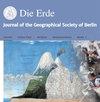印度尼西亚615 ka至今的气候变率:来自低分辨率耦合模式模拟的初步见解
IF 0.6
4区 地球科学
Q3 GEOGRAPHY
引用次数: 0
摘要
我们使用CCSM3-DGVM模型模拟的一组13个时间片实验的结果来分析印度尼西亚水域的动态。研究了海洋同位素阶段(MIS) 1、5、11、13和15的第四纪间冰期之间和内部的全球气候变率。在印尼大部分地区的北方夏季(6 - 7 - 8 - 9月),季节性地表温度异常在很大程度上可以用天文强迫引起的局地日照异常来解释。然而,在某些时间段内,气候反馈可能会改变印度尼西亚的地表温度响应,在靠近印度洋和太平洋的开阔水域最为明显。与工业化前(PI)条件相比,最温暖的夏季海表温度(SST)异常出现在班达海125 ka (MIS 5)和579 ka (MIS 15)。495 ka (MIS 13)至-2 K的最冷夏季海温异常均匀分布在印度尼西亚海域。在寒带冬季,印度尼西亚大部分土地和水域的大部分温和降温也与局部日照有关。本研究最有趣的发现是,在印度尼西亚海域西部、印度洋到班达海以及印度尼西亚海域东部,发现了一种偶极子和三极子降水模式,在北方夏季降雨量异常高达3.6 mm/d。这项研究的结果有望作为预测印度尼西亚现在和未来气候的基本信息。这可能有助于IPCC提供的评估,以便更好地了解该地区未来的气候变化,这是减轻其影响的先决条件。本文章由计算机程序翻译,如有差异,请以英文原文为准。
Climate Variability in Indonesia from 615 ka to present: First Insights from Low-Resolution Coupled Model Simulations
We analyse the dynamics of Indonesian waters using the results of a set of 13 time-slice experiments simulated by the CCSM3-DGVM model. The experiments were carried out to study global climate variability between and within the Quaternary interglacials of Marine Isotope Stages (MIS) 1, 5, 11, 13, and 15. During boreal summer (June-July-August-September), in most of Indonesia, seasonal surface temperature anomalies can largely be explained by local insolation anomalies induced by the astronomical forcing. However, for some time slices, climate feedbacks may modify the surface temperature response in Indonesia, most pronounced in open water close to the Indian and Pacific Oceans. The warmest boreal summer sea-surface temperature (SST) anomaly compared to Pre-Industrial (PI) conditions of up to 1 K was found in the Banda Sea at 125 ka (MIS 5) and 579 ka (MIS 15). The coolest boreal summer SST anomaly down to –2 K at 495 ka (MIS 13) is equally distributed in Indonesian waters. During boreal winter, most of the moderate cooling over large portions of the land and the waters of Indonesia is also associated with local insolation. The most interesting finding in this study, a dipole and tripole precipitation pattern with up to 3.6 mm/day of rainfall anomaly during boreal summer is identified in the western part of the Indonesian waters, Indian Ocean to Banda Sea, and the eastern part of Indonesian waters. The results of this study are expected to be used as basic information to predict the climate in Indonesia for the present and future. This may add to the assessment provided by the IPCC for a better understanding of future climate change in the region, which is a prerequisite for alleviating its impacts.
求助全文
通过发布文献求助,成功后即可免费获取论文全文。
去求助
来源期刊

Erde
GEOGRAPHY, PHYSICAL-GEOSCIENCES, MULTIDISCIPLINARY
CiteScore
2.90
自引率
6.20%
发文量
0
审稿时长
>12 weeks
期刊介绍:
DIE ERDE is a publication of the Geographical Society of Berlin
DIE ERDE is a scientific journal in Geography, with four issues per year with about 100 pages each. It covers all aspects of geographical research, focusing on both earth system studies and regional contributions.
DIE ERDE invites contributions from any subfield of both Physical and Human Geography as well as from neighbouring disciplines.
 求助内容:
求助内容: 应助结果提醒方式:
应助结果提醒方式:


